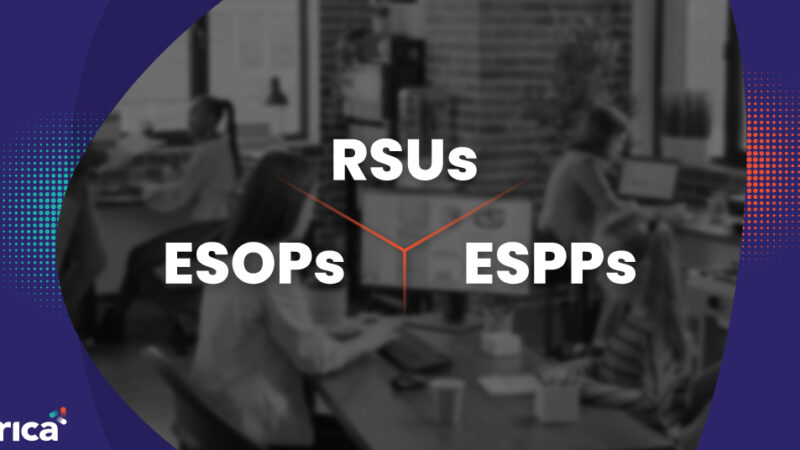
Complete Legal Overview on Sweat Equity Shares
With the government notification that came out on Tuesday night, the issue of ESOPs and “Sweat Equity” is back in focus. Financial news portal – Finshots has a good summary – “…until now; startups were allowed to offer sweat equity for about 5 years post the date of incorporation. However, considering the extraordinary circumstances, the government has extended the limit to 10 years. The government also said startups can now offer sweat equity shares of up to 50% of their paid-up capital instead of 25% earlier. Meaning startups can now afford to offer more sweat equity to their employees, and this ideally should give them extra leeway to hire and retain talent. But bear in mind, this benevolence has only been extended to startups (recognized by DPIIT).”
But let’s take a step back and understand the basic difference between Sweat Equity and ESOPs:
“Sweat Equity” shares mean equity shares issued by a company to its employees or directors at a discount or for consideration other than cash. In other words, it refers to the allotment of equity shares to employees as compensation for the efforts and hard work (aka sweat) in providing intangibles, like growth or success, for the company.
In the case of ESOPs, employees need not be allotted actual shares of the company until exercise or a liquidity event. However, in the case of Sweat Equity, the shares are immediately allotted to the employee.
To understand the difference between the two in more detail, read this article.
Companies Act on Sweat Equity Shares
Companies Act, 2013 Section 54 – Issue of sweat equity shares –
- Notwithstanding anything contained in section 53, a company may issue sweat equity of a class of shares already issued if the following conditions are fulfilled, namely: —
- The issue is authorized by a special resolution passed by the company;
- The resolution specifies the number of shares, the current market price, consideration if any, and the class or classes of directors or employees to whom such equity shares are to be issued;
- Not less than one year has, at the date of such issue, elapsed since the date on which the company had commenced business; and
- Where the company’s equity shares are listed on a recognized stock exchange, sweat equity is issued following the regulations made by the Securities and Exchange Board on this behalf. If they are not so listed, the sweat equity shares are issued following such rules as may be prescribed.
- The rights, limitations, restrictions, and provisions as are for the time applying to equity shares shall apply to the sweat equity shares issued under this section, and the holders of such shares shall rank pari passu with other equity shareholders.
- The issue is authorized by a special resolution passed by the company;
Companies (Share Capital and Debentures) Rules, 2014: Excerpt of Rule 8. Issue of sweat equity shares:
- A company other than a listed company, which is not required to comply with the Securities and Exchange Board of India Regulations on sweat equity, shall not issue sweat equity shares to its directors or employees at a discount or for consideration other than cash, for their providing know-how or making available rights like intellectual property rights or value additions, by whatever name called, unless the issue is authorized by a special resolution passed by the company in general meeting. Explanation. — For this rule—
- The expression “Employee” means—
- A permanent employee of the company who has been working in India or outside India for at least the last one year; or
- A director of the company, whether a whole-time director or not; or
- An employee or a director as defined in sub-clause (a) or (b) above of a subsidiary, in India or outside India, or of a holding company of the company;
- The expression ‘Value additions’ means actual or anticipated economic benefits derived or to be derived by the company from an expert or a professional for providing know-how or making available rights in the nature of intellectual property rights, by such person to whom sweat equity is being issued for which the consideration is not paid or included in the normal remuneration payable under the contract of employment, in the case of an employee.
- The expression “Employee” means—
- The explanatory statement to be annexed to the notice of the general meeting pursuant to section 102 shall contain the following particulars, namely: —
- The date of the Board meeting at which the proposal for the issue of sweat equity shares was approved;
- The reasons or justification for the issue;
- The class of shares under which sweat equity shares are intended to be issued;
- The total number of shares to be issued as sweat equity;
- The class or classes of directors or employees to whom such equity shares are to be issued;
- The principal terms and conditions on which sweat equity shares are to be issued, including the basis of valuation;
- The time period of association of such person with the company;
- The names of the directors or employees to whom the sweat equity shares will be issued and their relationship with the promoter or/and Key Managerial Personnel;
- The price at which the sweat equity shares are proposed to be issued;
- The consideration including consideration other than cash, if any to be received for the sweat equity; (k) the ceiling on managerial remuneration, if any, be breached by the issuance of such sweat equity and how it is proposed to be dealt with;
- A statement to the effect that the company shall conform to the applicable accounting standards; and
- Diluted earning per share pursuant to the issue of sweat equity shares, calculated in accordance with the applicable accounting standards.
- The special resolution authorizing the issue of sweat equity shares shall be valid for making the allotment within a period of not more than twelve months from the date of passing of the special resolution.
- The company shall not issue sweat equity for more than fifteen percent of the existing paid-up equity share capital in a year or shares of the issue value of rupees five crores, whichever is higher: Provided that the issuance of sweat equity shares in the Company shall not exceed twenty-five percent, of the paid-up equity capital of the Company at any time:
Provided further that a startup company, as defined in notification number GSR 180(E) dated 17th February 2016 issued by the Department of Industrial Policy and Promotion, Ministry of Commerce and Industry, Government of India, may issue sweat equity shares not exceeding fifty percent of its paid-up capital up to five years from the date of its incorporation or registration. - The sweat equity shares issued to directors or employees shall be locked in/non-transferable for a period of three years from the date of allotment, and the fact that the share certificates are under lock-in and the period of expiry of lock-in shall be stamped in bold or mentioned in any other prominent manner on the share certificate.
- The sweat equity shares to be issued shall be valued at a price determined by a registered valuer as the fair price, which justifies such valuation.
- The valuation of intellectual property rights or of know-how or value additions for which sweat equity shares are to be issued shall be carried out by a registered valuer, who shall provide a proper report addressed to the Board of directors with justification for such valuation.
- A copy of the gist, along with critical elements of the valuation report obtained under clauses (6) and (7), shall be sent to the shareholders with the notice of the general meeting.
- Where sweat equity is issued for a non-cash consideration based on a valuation report in respect thereof obtained from the registered valuer, such non-cash consideration shall be treated in the following manner in the books of account of the company—
- Where the non-cash consideration takes the form of a depreciable or amortizable asset, it shall be carried to the balance sheet of the company in accordance with the accounting standards; or
- Where clause (a) is not applicable, it shall be expensed as provided in the accounting standards.
- The amount of sweat equity shares issued shall be treated as part of managerial remuneration for the purposes of sections 197 and 198 of the Act, if the following conditions are fulfilled, namely: —
- The sweat equity shares are issued to any director or manager; and
- They are issued for consideration other than cash, which does not take the form of an asset that can be carried to the company’s balance sheet in accordance with the applicable accounting standards.
- In respect of sweat equity shares issued during an accounting period, the accounting value of sweat equity shares shall be treated as a form of compensation to the employee or the director in the financial statements of the company if the sweat equity shares are not issued pursuant to the acquisition of an asset.
- If the shares are issued pursuant to the acquisition of an asset, the value of the asset, as determined by the valuation report, shall be carried in the balance sheet as per the Accounting Standards and such amount of the accounting value of the sweat equity shares that are more than the value of the asset acquired, as per the valuation report, shall be treated as a form of compensation to the employee or the director in the financial statements of the company.
Explanation — For the purposes of this sub-rule, it is hereby clarified that the Accounting value shall be the fair value of the sweat equity shares as determined by a registered valuer under sub-rule (6). - The Board of Directors shall, inter alia, disclose in the Directors’ Report for the year in which such shares are issued the following details of the issue of sweat equity shares namely: —
- The class of director or employee to whom sweat equity was issued;
- The class of shares issued as Sweat Equity;
- The number of sweat equity shares issued to the directors, key managerial personnel, or other employees showing separately the number of such shares issued to them, if any, for consideration other than cash and the individual names of allottees holding one percent or more of the issued share capital;
- The reasons or justification for the issue
- The principal terms and conditions for issue of sweat equity shares, including pricing formula;
- The total number of shares arising as a result of the issue of sweat equity shares;
- The percentage of the sweat equity shares of the total post issued and paid-up share capital;
- The consideration (including consideration other than cash) received or benefit accrued to the company from the issue of sweat equity shares;
- The diluted Earnings Per Share (EPS) pursuant to the issuance of sweat equity.
- Compliance Registers
- The company shall maintain a Register of Sweat Equity Shares in Form No. SH.3 and shall forthwith enter therein the particulars of Sweat Equity Shares issued under section 54.
- The Register of Sweat Equity Shares shall be maintained at the company’s registered office or such other place as the Board may decide.
- The entries in the register shall be authenticated by the Company Secretary of the company or by any other person authorized by the Board for the purpose.
Determination of Fair Market Value of shares:
Rule 3 of the Income-tax Rules, 1961 prescribes the rules for the valuation of perquisites. According to Rule 3(8), the fair market value of an equity share in a company, on the date on which the employee exercises the option, shall be determined in the following manner:
- In a case where, on the date of the exercising of the option, the share in the company is listed on a recognized stock exchange, the fair market value shall be the average of the opening price and closing price of the share on that date on the said stock exchange; Provided that where, on the date of exercising of the option, the share is listed on more than one recognized stock exchanges, the fair market value shall be the average of opening price and closing price of the share on the recognized stock exchange which records the highest volume of trading in the share; Provided further that where, on the date of exercising of the option, there is no trading in the share on any recognized stock exchange, the fair market value shall be—
- the closing price of the share on any recognized stock exchange on a date closest to the date of exercising of the option and immediately preceding such date; or
- the closing price of the share on a recognized stock exchange, which records the highest volume of trading in such share, if the closing price, as on the date closest to the date of exercising of the option and immediately preceding such date, is recorded on more than one recognized stock exchange.
- In a case where, on the date of exercising of the option, the share in the company is not listed on a recognized stock exchange, the fair market value shall be such value of the share in the company as determined by a merchant banker on the specified date.
- For the purpose of this sub-rule, —
- “closing price” of a share on a recognized stock exchange on date shall be the price of the last settlement on such date on such stock exchange. Provided that where the stock exchange quotes both “buy” and “sell” prices, the closing price shall be the “sell” price of the last settlement;
- “merchant banker” means category I merchant banker registered with SEBI;
- “opening price” of a share on a recognized stock exchange on date shall be the price of the first settlement on such date on such stock exchange. Provided that where the stock exchange quotes both “buy” and “sell” prices, the opening price shall be the “sell” price of the first settlement;
- “recognized stock exchange” shall have the same meaning assigned to it in section 2(f) of the
Securities Contracts (Regulation) Act, 1956; - “specified date” means, —
- The date of exercising of the option; or
- Any date between the date of exercising of the option and 180 days earlier than the date of the
exercising.
Click here for a detailed blog on how Sweat Equity works.
Check out trica equity and digitize your entire equity stack!
Disclaimer: This article has been prepared for general guidance on the subject matter and does not constitute professional advice. The matters described herein are general in nature and have not been evaluated based on applicable laws. You should not act upon the information contained in this note without obtaining specific professional advice. No representation or warranty (express or implied) is given as to the accuracy or completeness of the information contained in this note. LetsVenture Technologies Private Limited, its partners, employees, and agents accept no liability and disclaim all responsibility for the consequences of you or anyone else acting or refraining to act in reliance on the information contained in this publication or for any decision based on it. Without prior permission of LetsVenture Technologies Private Limited, this note may not be quoted in whole or in part or otherwise referred to any person or in any documents.
ESOP & CAP Table
Management simplified
Get started for free





